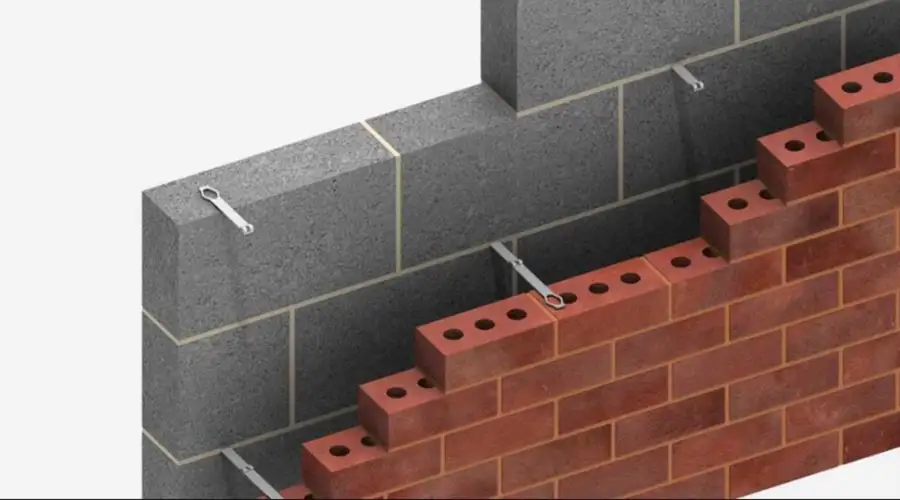Walls are the backbone of any building; they offer dynamic characteristics serving both functional and aesthetic purposes. They define the mood and reflect the personal styles of your interior spaces.
Brick walls not only help in creating partitions but also assist in distributing loads across the surfaces. There are different types of brick walls, each serving different applications. This blog explores different types of brick walls in construction in detail.
Different Types of Brick Walls
Solid Brick Walls

A solid brick wall is a single-layered structure that offers both aesthetic and structural values to the building. Such walls are made of high-quality clay bricks with high strength, durability and thermal insulation properties. These bricks are laid along the runner bond and bonded using the cement mortar. They are widely used for structures where withstanding heavy loads is crucial.
Cavity Walls

A cavity wall consists of two parallel walls with a cavity in between them, providing adequate insulation and moisture resistance. The choice of building materials depends on the structural requirements and external weather conditions. The outer walls protect the structure from external conditions, while the inner wall acts as a structural element. This wall offers enhanced energy efficiency and is widely used in modern construction.
Veneer Walls

A veneer wall is a non-structural layer of brick that is attached to a structural frame or load-bearing wall. Lightweight bricks or veneers are bound with the frame using mortar or adhesive. The main function of the veneer walls is to provide an aesthetically pleasing look, with the structural frame helping in withstanding loads. These walls are used in high-rise commercial and residential buildings for brick wall interior designing
Reinforced Brick Walls
Reinforced brick walls involve providing steel reinforcements within the brickwork to offer additional strength, enabling them to withstand heavy loads without causing cracks or failing. The reinforcements used in the walls run in both directions depending on the design and load requirements. These walls are used for load-bearing walls of large structures, especially in areas prone to high seismic activity
Double Whythe Walls
A double wythe wall is made up of two layers (wythes) of brick, which when bonded together form a thicker and stronger wall. The wythes are typically laid in a running bond pattern, where bricks in each course are offset. In some cases, metal ties are used to bond the layers together to provide additional strength and stability. These walls offer good thermal and sound insulation and protect the structure from various external weather conditions. They provide excellent insulation properties due to their thickness.
Types of Special Purpose Brick Walls
Special-purpose brick walls are specially designed to fulfill particular construction needs. The bricks used in these walls are specially engineered for that particular purpose. There are different types of special-purpose brick walls in the industry such as fire-resistant walls, soundproofing walls, load-bearing walls, and non-load-bearing walls.
Fire Resistant Walls
Fire-resistant walls are specially designed for fireplaces and places of high temperatures. This type of wall uses fire bricks or refractory bricks that are burnt in high temperatures. These bricks when combined with mortar having fire-resistance properties, create a fire wall. Such walls need to be sealed carefully to prevent the spread of heat or smoke. These walls are used in fire-prone areas such as fire pits, fire kilns, and other commercial and residential buildings to offer fire safety.
Soundproofing Walls
Soundproofing walls are specially designed to provide sound insulation, cutting the external noises entering the internal structures. These walls are built with denser brick, and the cavity is usually filled with acoustic insulation. They are sealed carefully without any gaps for enhanced noise reduction. These walls are used in the construction of offices, apartments, hospitals, cinema halls and recording studios.
Load-Bearing Walls
These walls are specifically designed to withstand heavy loads from floors, roofs, and structural elements of the building. These walls are built using dense and durable bricks that are specially engineered for such purposes. Load-bearing walls are used in multi-storey buildings and commercial structures, where it’s crucial that they can accommodate the heavy loads of overlying floors and roof structures.
Non-Load-Bearing Walls
Non-load-bearing walls are used for partitioning spaces, providing privacy, and thermal and acoustic insulation. The bricks used for these walls have less strength and durability when compared to other bricks. These walls cannot withstand heavy loads and are therefore used only for design and partition purposes.
Conclusion
In summary, there are different types of brick walls, and each having its distinctive advantages tailored to serve specific construction needs. Solid and cavity walls provide good structural integrity and insulation properties. Veneer walls offer enhanced aesthetics. Reinforced walls and double wythe walls provide high durability and strength. On the other hand, special-purpose brick walls are made to serve a specific functions. By understanding the properties and installation techniques, one can choose the right brick wall based on your construction requirements.
FAQs
Solid brick walls, cavity brick walls, and veneer brick walls are three common types of brick walls used in construction.
Brick walls that use Class A engineered bricks are highly durable compared to brick walls made of other brick types.
Yes, brick masonry is a broader term that refers to the construction of any building structure using brick as the primary material. Thus, a brick wall is a type of masonry unit.

